Bulletin – March 2016 Finance Developments in Banks' Funding Costs and Lending Rates
- Download the article 1.4MB
Abstract
This article updates previous Reserve Bank research on how developments in the composition and pricing of banks' funding have affected their overall cost of funds and influenced lending rates. Major banks' outstanding funding costs fell notably in 2015, following two reductions in the cash rate. The spread between the major banks' outstanding funding costs and the cash rate also narrowed over 2015. This was due to lower costs of deposits and a more favourable mix of deposit funding, as well as lower wholesale funding costs. Lending rates declined in the first half of 2015, reflecting changes in the cash rate and competition for lending, before lending rates increased for housing in the second half of the year; business lending rates are at historically low levels.
Introduction
In setting lending rates, banks consider a number of factors. A key consideration is their cost of funding, which reflects the composition and price of the various liabilities (including deposits) issued by banks (Hack and Fabbro 2011). Banks also take into account risk premia, including the credit risk associated with loans, and the liquidity risk involved in funding long-term assets with short-term liabilities. Banks' growth strategies, competition and the desired return to equity holders also affect banks' lending rates.
An important element in determining the overall cost of banks' funding is the level of the cash rate, which acts as an anchor for the broader interest rate structure of the domestic financial system. Nevertheless, changes in the level of compensation demanded by investors to hold bank debt, competitive pressures and non-price factors (such as funding composition) can influence banks' funding costs significantly. There is typically some delay before the full effect of changes in these factors flows through to funding costs and lending rates. In part, this reflects the time that it takes for balance sheet liabilities to be repriced, particularly those with longer terms to maturity.
The Reserve Bank Board takes developments in banks' funding costs and lending rates into account when it determines the appropriate setting of the cash rate. The Board aims to ensure that interest rates faced by households and businesses are consistent with the desired stance of monetary policy. The following analysis updates previous Reserve Bank research and focuses on developments in banks' funding costs and lending rates over 2015 (Tellez 2015).
Funding
Composition
Banks fund themselves with a combination of liabilities, which includes deposits and wholesale debt, along with equity. Over the past decade banks have made less use of wholesale funding – particularly short-term debt – and more use of domestic deposits (Graph 1). Banks began increasing their share of deposit funding following the global financial crisis as they sought more stable forms of funding. The share of deposit funding stabilised at just below 60 per cent of total funding liabilities in 2014, an increase of nearly 20 percentage points in six years. More recently, the share of deposit funding has declined a little as the relative cost of wholesale debt has fallen and the major banks have raised equity to meet upcoming changes to prudential regulation.
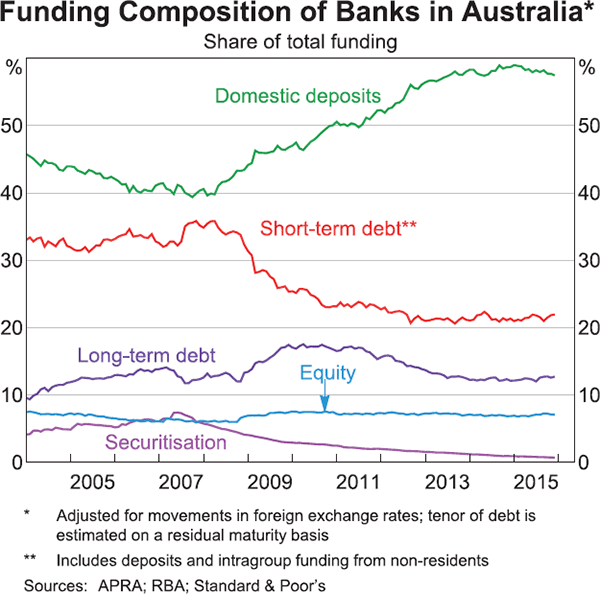
Debt funding costs
In aggregate, debt funding costs (hereafter ‘funding costs’) for the major banks are estimated to have fallen by around 70 basis points over 2015, partly reflecting a reduction in the cash rate of 25 basis points in February and then again in May. The spread of major banks' funding costs to the cash rate is estimated to have narrowed over 2015 owing to the fact that both deposit rates and wholesale funding costs declined by more than the cash rate in the year (Graph 2). Compositional shifts within the mix of deposits and wholesale funding also contributed to the narrowing in the spread.
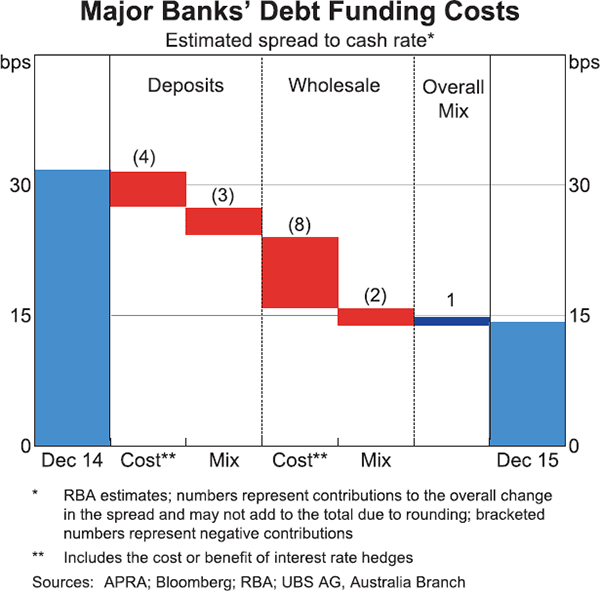
Much of the fall in funding costs relative to the cash rate occurred over the first half of 2015, with major banks' outstanding funding costs estimated to have been relatively stable over the second half of the year. Notwithstanding these developments, the spread of major banks' funding costs to the cash rate remains higher than it was in the period before the global financial crisis.
Deposit funding
Over 2015, declines in major banks' overall deposit costs relative to the cash rate were driven roughly in equal part by lower deposit rates and changes in the composition of deposits. An easing of competition in the deposit market saw the cost of deposits contribute 4 basis points to the lower spread of total funding costs to the cash rate. Banks were able to price their deposit products such that the flow of deposits was predominantly into at-call and transaction accounts, rather than into more expensive term deposit funding. This resulted in a change in the composition of deposits that contributed a further 3 basis points to the reduction in the funding cost spread to the cash rate.
Deposit interest rates
Interest rates offered on the majority of deposits declined over the year, roughly in line with reductions in the cash rate. Some interest rates declined further, reflecting reduced demand for deposit funding by the banks (Graph 3). The outstanding costs on bonus and online savings accounts declined the most over 2015 (by between 70 and 95 basis points). For term deposits, the outstanding cost is estimated to have declined by almost 70 basis points as deposits that were issued at higher rates matured and were replaced by new deposits at lower rates, which incorporated the changes in the cash rate.
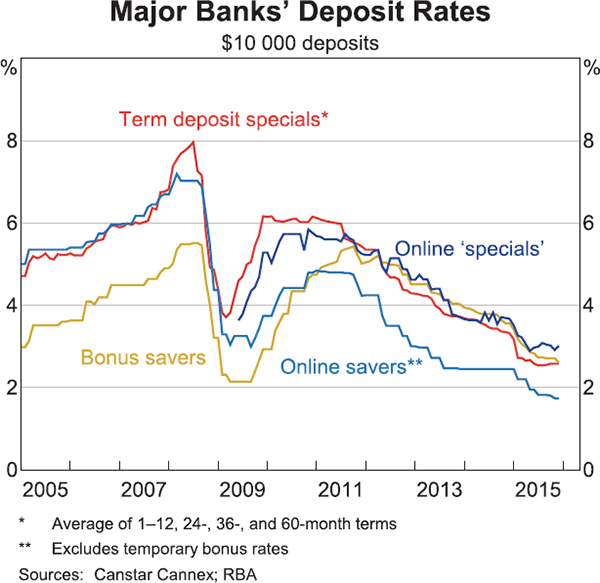
At-call savings accounts (such as bonus and online savers) and transaction accounts have been a preferred source of deposit funding by banks for some time. One reason for this is that banks are able to adjust the rates on these accounts (and hence, costs) instantaneously, rather than setting the rate for a fixed period. Also, these current accounts tend to be a more stable source of funding in the medium term and, reflecting this, they are treated more favourably than term deposits maturing within 30 days under the current prudential Liquidity Coverage Ratio (LCR) framework (APRA 2014).
Banks continue to offer term deposit specials for attracting deposits with a specific term to maturity, providing some control over the maturity profile of these deposits. Typically, these specials are for terms of 3–4, 6–8 or greater than 12 months and offer an additional 10–40 basis points on standard rates.
Following the implementation of the LCR, the majority of banks introduced non-breakable clauses on their term deposit accounts. This ensures that the term deposit does not attract a penalty under the LCR for as long as the term to maturity of the deposit remains greater than 30 days.
While interest rates on bonus and online saver accounts are, in some instances, above those for term deposit ‘specials’, the former accounts typically require additional funds to be deposited regularly or have limits on monthly withdrawals to be eligible for the higher interest rates. Some proportion of funds in bonus and online saver accounts do not meet these conditions and so have significantly lower effective interest rates than advertised. For instance, some bonus saver accounts currently offer bonus interest rates of around 260 basis points, but require that no withdrawals be made to be eligible for the interest. For online specials, most ‘base rates’ fell by more than the cash rate, while the ‘special’ component of the interest rates increased.
Some banks offer notice accounts to customers, which require a minimum notice period (often 31 days) to withdraw funds. These are another form of stable funding for banks. Advertised interest rates on these accounts tend to be in line with term deposit ‘specials’ and, to date, these accounts have not become a substantial source of funding.
Deposit mix
Consistent with the large fall in interest rates on term deposits, the level of term deposits in the system declined in 2015, mostly due to some maturing deposits not being rolled over. In contrast, transaction and at-call savings deposits grew strongly in the year (Graph 4). Throughout 2015, banks also adopted pricing strategies aimed at reducing deposits from institutional depositors (such as superannuation funds), which are more costly to banks under the LCR framework.
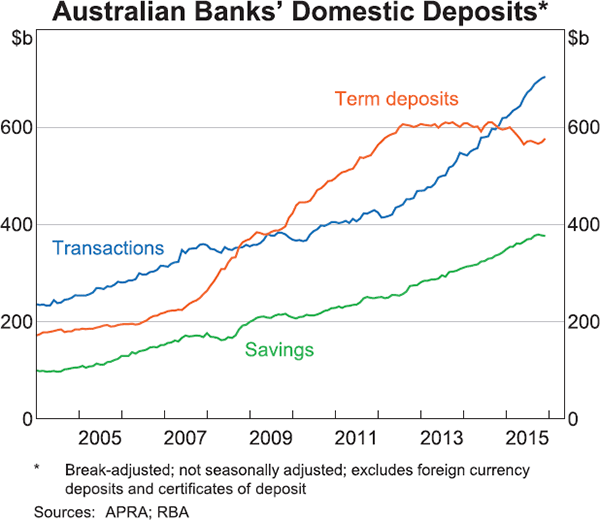
The change in the mix of deposit funding lowered the cost of those funds by 3 basis points owing to particularly strong growth in transaction deposits, which carry lower interest payments. In part, this reflects the rapid growth of mortgage offset account balances through 2015, where funds are typically deposited in zero-interest rate accounts but are used to reduce the calculated interest on the associated mortgage (Graph 5). One implication of the increased use of such accounts is the high ‘implied’ cost of funds for banks – equivalent to interest forgone on mortgages. Interest rates on mortgages are much higher than those on deposit products, so banks implicitly pay their customers the mortgage rate on funds held in offset accounts. However, money held in offset only accounts for about 6½ per cent of at-call deposits.
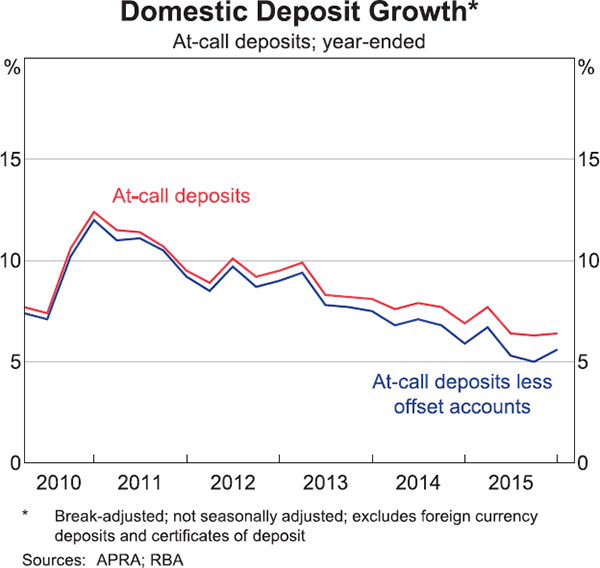
Wholesale funding
The volume of bank bond issuance in 2015 was broadly similar to the previous year, although banks issued slightly less in covered bonds and residential mortgage-backed securities (RMBS) (Graph 6).
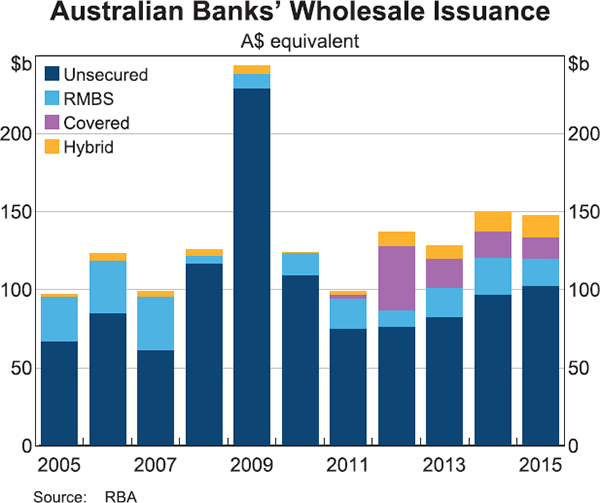
Issuance of hybrid securities (hybrids) has steadily increased since 2012, and banks' hybrid issuance was slightly higher in 2015 than the previous year, possibly reflecting proposed international prudential standards which call for a higher share of such funding. The mix of wholesale funding outstanding was little changed over the year. A shift from offshore long-term debt to offshore short-term debt contributed to a marginal reduction in funding costs for the major banks (Graph 7).[1] However, the share of major banks' total funding from offshore short-term debt remains below that for the banking sector as a whole, reflecting the fact that some other institutions, particularly foreign banks, make more extensive use of such funding (Graph 8).
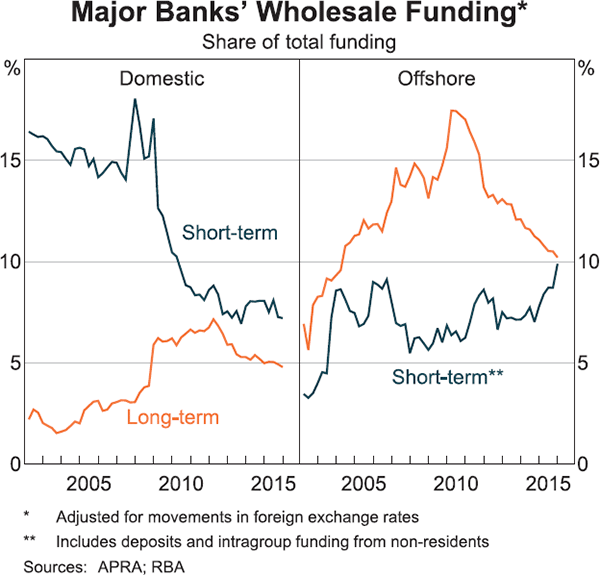
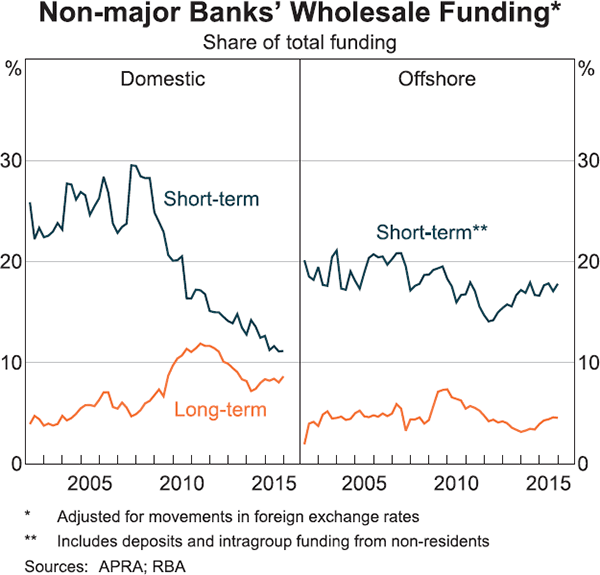
During 2015, declines in wholesale funding rates and the roll over of existing higher-rate funding lowered the major banks' funding costs by 8 basis points more than the reduction in the cash rate. Yields on major banks' senior unsecured debt largely moved in line with sovereign and swap rates, and yields in 2015 were on average lower than in the previous year (Graph 9). The modest widening in spreads on bank debt to Australian Government securities (AGS) and swap rates towards the end of the year was associated with perceptions of increased global macroeconomic risks and a rise in the cost of funding in other markets, particularly in US dollars.
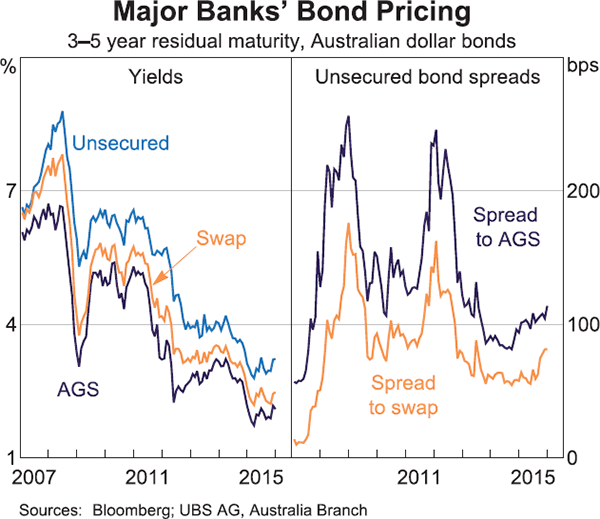
The all-up cost to banks of issuing new wholesale debt fell substantially at the beginning of 2015. The lower level was sustained through most of the year. This gradually flowed through to outstanding wholesale funding costs as the new cheaper debt replaced higher cost maturing funding (Graph 10).
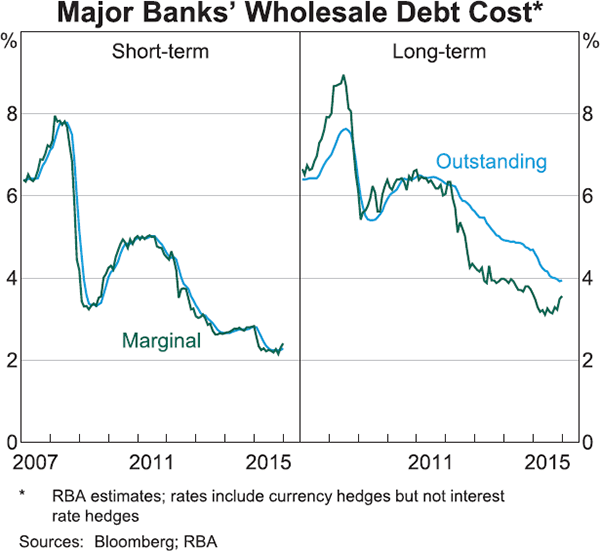
Towards the end of 2015, the cost of issuing new debt increased. Yields on new short-term debt rose to be higher than those on outstanding short-term debt, while the cost of new long-term debt was a little below the cost of corresponding outstanding debt. One component of the cost of long-term debt is the spread which banks pay above the swap rate (interest rate swaps are used to convert fixed rate debt into floating rate debt). The estimated spread to the swap rate on new issuance in the domestic market rose to be slightly above the average of outstanding issuance, which suggests that there is some upward pressure on funding costs once the cost of hedging is taken into account (Graph 11).
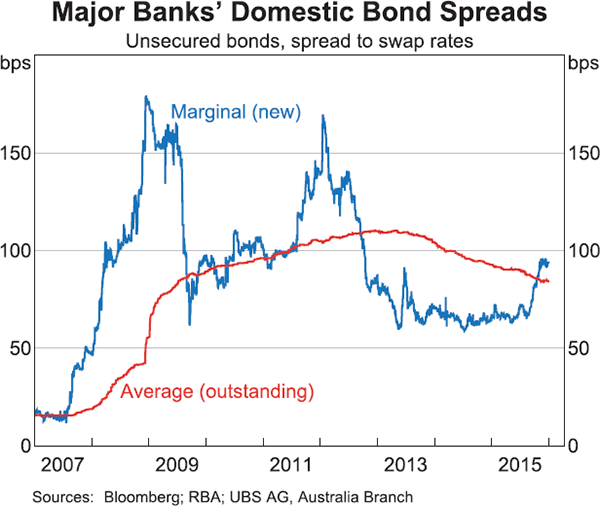
While the cost of hybrid funding outstanding has fallen by around 30 basis points over 2015, it remains costly relative to other wholesale funds and accounts for only a small share of total funding.
Cost of equity
Although equity tends to be a relatively small share of banks' aggregate balance sheets – around 6½ per cent – it is generally more expensive than debt, so small changes in equity funding shares can have proportionately large effects on total funding costs. Unlike debt funding, equity funding does not involve a legally contracted obligation to return the principal amount or pay a given return on funds. Given this, the cost of equity is the return that equity providers (shareholders) require in order to invest in the bank. For example, if potential shareholders will only invest in a bank if it makes a 10 per cent return on that equity – that is, annual returns after tax are 10 per cent of the amount of equity invested – then that is the cost of equity. Banks do not necessarily need to ‘pay out’ these returns, although they may distribute some of it in the form of dividends. If the required return is not achieved, or a bank does not pay a dividend, this is not a default and does not have the same consequences as when the bank fails to meet its debt obligations.
The ex ante cost of equity is not directly observable. However, historical data suggest that the major banks have provided a return on equity of around 15 per cent, which is relatively high by international standards (Graph 12).
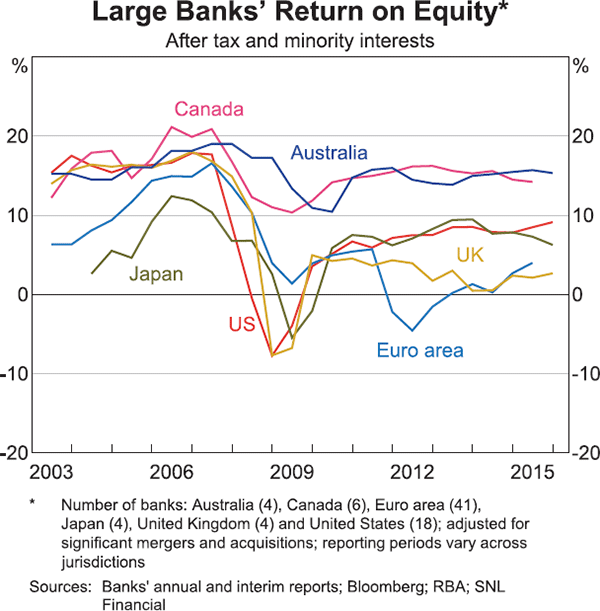
As noted earlier, the major banks raised a significant amount of equity in 2015 – around $21 billion – in anticipation of upcoming changes to prudential regulation (RBA 2015). These include announced increases to the share of equity funding to be required when making mortgages, as recommended by the Financial System Inquiry (2014), which comes into effect on 1 July 2016.
The adjustment to the cost of additional equity can occur in three ways, which are not mutually exclusive. First, banks can raise the return on assets (e.g. interest rates on lending) in order to maintain historical returns on equity. Indeed, the banks cited the cost of equity as the reason for raising housing lending rates by 15–20 basis points in November (see below). Second, they can absorb the cost of the additional equity by allowing their return on equity to decline; it is estimated that if major banks had not recovered any of the additional cost of capital, their return on equity would have declined by around 1½ percentage points. However, higher capital levels reduce the risk of bank failure, which may result in a lower risk premium in the cost of equity. Third, because the additional equity reduces risk, debt funding costs may also be lower, which could offset some of the effect of the higher cost of the equity funding.
Other Australian Banks
In aggregate, the other Australian banks' funding liabilities look similar to the major banks (Graph 13). However, there is greater variation in the funding composition of this group than exists between the major banks. The other Australian banks with a more traditional retail structure have a much higher use of deposit funding, at around 90 per cent of non-equity funding. These are smaller institutions with more limited access to capital markets. For those banks with less traditional structures, that is, those with large non-banking financial activities, the deposit share is in some cases closer to 50 per cent.
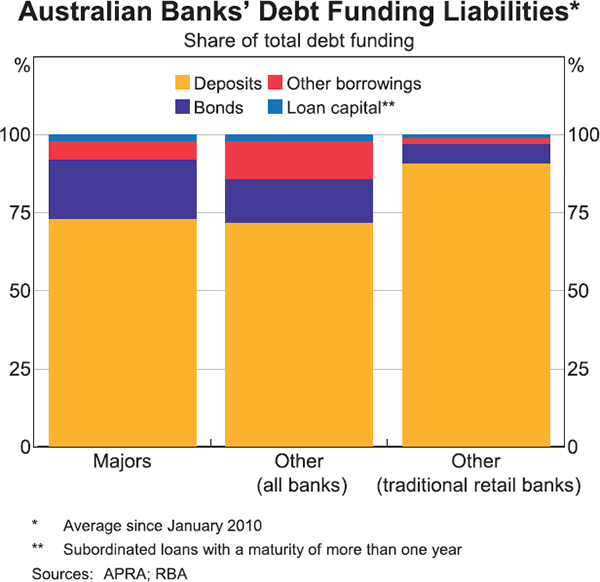
Prior to the global financial crisis, the aggregate funding costs of the major and other Australian banks followed each other fairly closely (Graph 14).[2] However, following the crisis a notable gap emerged, with funding costs for the other Australian banks around 105 basis points higher than for the majors from 2009 to 2011. Although this gap narrowed somewhat over subsequent years, it has widened again more recently to be around 75 basis points in 2015.
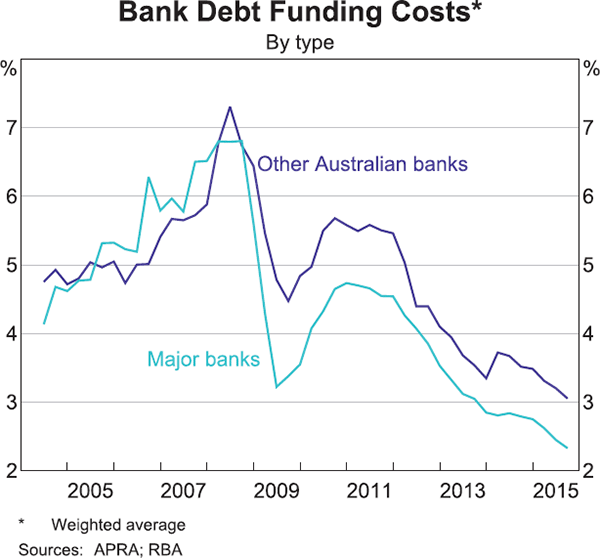
The primary driver of the difference in aggregate funding costs for the other Australian banks compared to the major banks since the crisis has been a divergence in the cost of both deposit and wholesale funding. This may suggest that investors and depositors now differentiate more between the risks of different banks than they did prior to the global financial crisis.
The spread of other Australian banks' funding costs to the cash rate decreased by around 10 basis points over the year to December (Graph 15). The change in the spread was due to the cost of deposits and wholesale funding decreasing by more than the cash rate, similar to developments for the major banks. This was partially offset by a compositional shift in funding towards wholesale debt, which remains a more expensive source of funding than deposits.
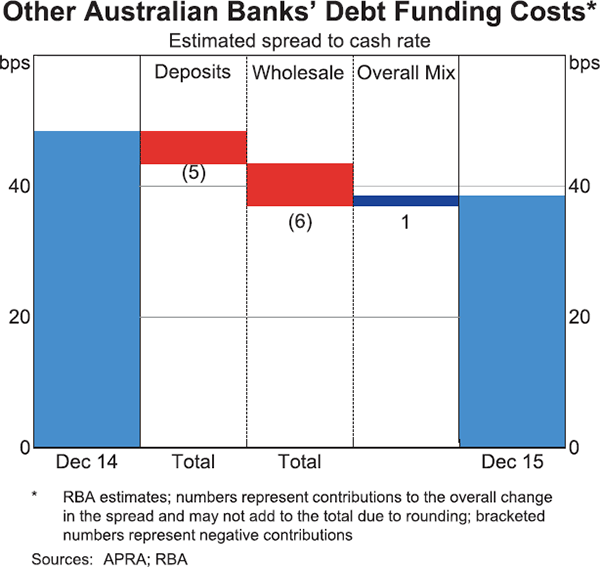
Lending Rates
Housing rates generally declined in line with the cash rate in the first half of 2015, with the average outstanding interest rate on mortgages falling by around 50 basis points over that period.
In the second half of the year, however, banks adjusted their lending rates such that the average outstanding housing interest rate for investor loans was only modestly lower over 2015, while rates for owner-occupiers declined by roughly 30 basis points over the year (Graph 16). Interest rates on investor loans were increased midyear, following concerns raised by APRA about the pace of growth in lending to investors. Increases in investor lending rates ranged from around 20–40 basis points, and were applied to both new and existing investor loans.
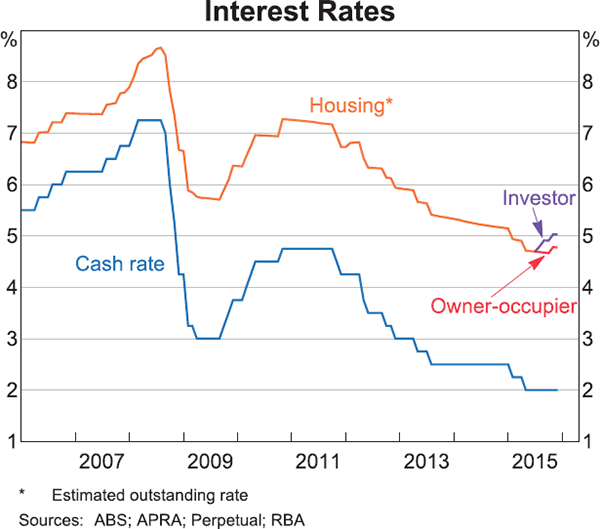
In November, the major banks raised mortgage rates across both investor and owner-occupier loans by 15–20 basis points, citing the cost of raising additional equity to meet incoming regulatory requirements. Of particular relevance, the Financial System Inquiry's Final Report recommended higher capital requirements for banks using ‘advanced’ risk modelling (the major banks and Macquarie Bank) in order to reduce a competitive disadvantage relative to other mortgage lenders (FSI 2014). The other Australian banks similarly increased mortgage lending rates, despite not facing the same regulatory costs as the major banks.
Business rates generally fell by more than the cash rate in 2015, with large business rates falling by around 70 basis points and small business rates by around 60 basis points. These lending rates remain at historic lows. Banks reported that declines in business rates beyond the changes in the cash rate were driven by intense competition for lending, including from the Australian operations of foreign lenders.
Banks' Implied Spread
Major banks
The major banks' implied spread, being the difference between average lending rates and debt funding costs, increased by around 20 basis points over 2015. This change was driven in roughly equal parts by the decline in average funding costs relative to the cash rate, and an increase in the average lending rate. However, lending rates and debt funding costs tend to move in line with each other in the longer run (Graph 17).
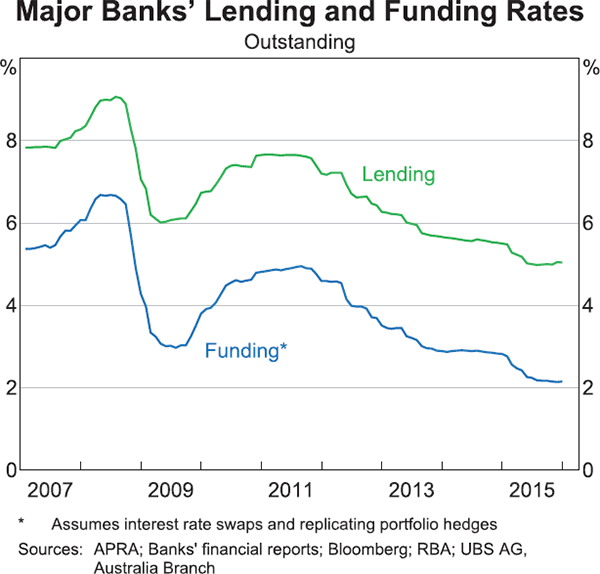
The contribution to the aggregate implied spread from higher lending rates was entirely due to increases in housing lending rates, with the implied spread on housing lending now higher than the previous peak in 2009. However, the measure of funding costs used to calculate implied spreads does not account for the increased share of relatively expensive equity funding. As such, the increase in the implied spread for housing lending is likely to overstate the true change in major banks' margins for this activity.
Implied spreads on business lending declined over 2015. Consistent with strong competition, implied spreads on large business lending have returned to pre-global financial crisis levels, when there was strong competition, business conditions were highly favourable and risk premia were compressed. Much of the competition is coming from foreign banks, with the average rate on business loans written by foreign banks significantly lower than the rate being charged by Australian banks (Graph 18).
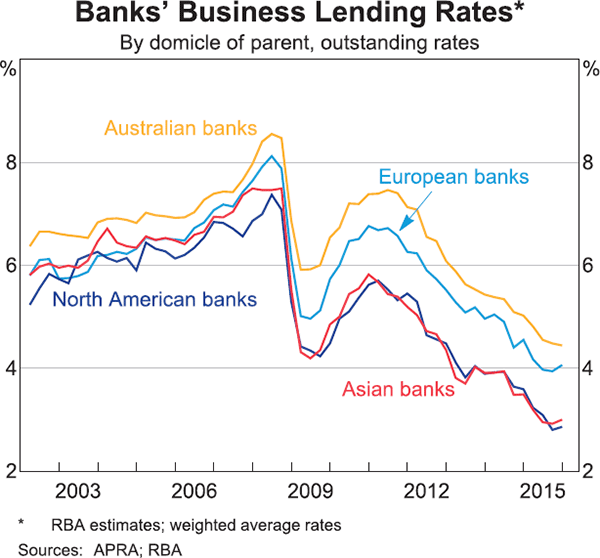
Other Australian banks
The average implied spread on other Australian banks' lending has been around 25 basis points lower than for the major banks since 2005. However, there is considerable variation in implied spreads of the other Australian banks, driven more by the high variation in lending interest rates across banks than variations in funding costs (Graph 19).
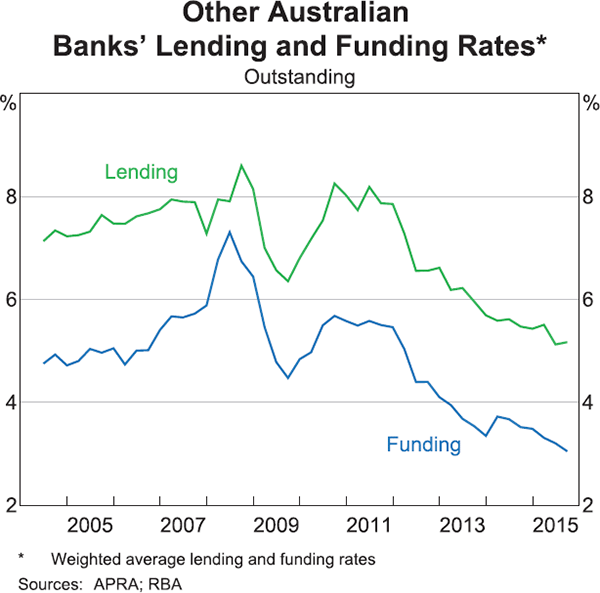
In contrast to the major banks, the spread on other Australian banks' lending for housing declined over 2015 with their lending rates falling by more than their funding costs. The other Australian banks' spread on business lending also decreased in 2015. The spread on business lending remains higher for the other Australian banks, which reflects the fact that these banks generally lend more to smaller business than the major banks, and do not compete as heavily with the major and foreign banks on large business lending.
Footnotes
The authors completed this work in Domestic Markets Department. [*]
Short-term offshore wholesale funding is defined as non-resident deposits and non-resident debt securities issued overseas with a residual maturity of less than 12 months (inclusive of Australian dollar-denominated and foreign currency-denominated securities), as reported to APRA. Residual maturity is useful for assessing banks' funding task for the period ahead, but overstates the issuance of new short-term debt and understates long-term issuance. The data presented in Graph 7 and Graph 8 are on an original maturity basis, however, which is useful for examining banks' access to the relevant markets. [1]
Owing to the use of alternative data sources, the data for major and other Australian banks in this section are not directly comparable to the data for major banks in other parts of this article. [2]
References
APRA (Australian Prudential Regulation Authority) (2014), ‘Prudential Standard APS 210 Liquidity’, November.
FSI (Financial System Inquiry) (2014), Financial System Inquiry Final Report, (D Murray, Chairperson), Commonwealth Government of Australia, Canberra.
Hack M and D Fabbro (2011), ‘The Effects of Funding Costs and Risk on Banks' Lending Rates’, RBA Bulletin, March, pp 35–41.
RBA (Reserve Bank of Australia) (2015), ‘Domestic Financial Markets’, Statement on Monetary Policy, November, pp 47–57.
Tellez E (2015), ‘Developments in Banks' Funding Costs and Lending Rates’, RBA Bulletin, March, pp 55–61.